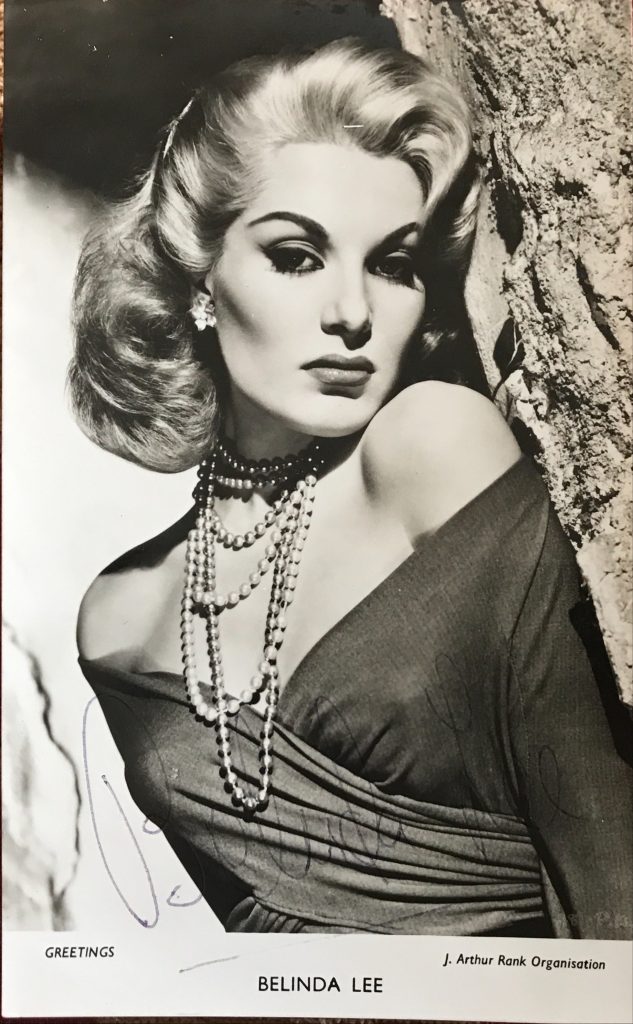

Green-eyed blonde Belinda Lee was born in Devon, England to florist Stella Mary Graham and hotel owner Robert Esmond Lee on June 15, 1935. Nicknamed “Billie,” she was an incredible beauty while still a teen attending the Rookesbury Park Prep School in Hampshire and St. Margaret’s boarding school in Devon. Expressing an avid interest in acting, she focused on dramatics at the Tudor Arts Academy at Surrey (1947), then gained entry via a scholarship to London’s RADA, at which she made her stage debut in “Point of Departure.”
Sharp-faced Belinda was noticed by Rank Studio director Val Guest while performing at the Nottingham Playhouse. She was artificially groomed in starlet parts, the first being The Runaway Bus (1954), until Guest helped her obtain a movie contract with Rank and introduced her to one of Rank’s prime still photographers, Cornel Lucas. That year she married the much-older Lucas, who helped promote her as a sex goddess with thousands of glamorous photographs.
Belinda was promoted as a docile young beauty, but her parts grew sexier. She worked intently in films but became frustrated with being stereotyped as a buxom peroxide blonde. Boxed in as a second-string Diana Dors, she played a sensuous foil to Benny Hill in Who Done It? (1956) and was served up as sexy window-dressing opposite both John Gregson in Miracle in Soho (1957) and Louis Jourdan in Dangerous Exile (1957).
Now estranged from Lucas, Belinda headed off to Italy for a change of pace and atmosphere but only found more of the temptress roles she tried to avoid–Aphrodite, Messalina, and Lucrezia Borgia–in low-budget spectacles. She also became preoccupied with married men, one being Prince Filippo Orsini, whose position with the Vatican led to a major scandal. This particular turbulent romance and a dissipating relationship with the Rank Studio (her last picture for the studio was Nor the Moon by Night (1958) with Michael Craig) triggered a near-fatal suicide attempt with pills in January 1958. She later divorced Lucas and continued her torrid affair with Prince Orsini, then others.
It all ended much too soon for the 25-year-old when she decided to join her current love, the much-older Italian playboy/journalist/film producer Gualtiero Jacopetti, on a trip to Las Vegas, where he was working on a documentary (La donna nel mondo (1963). While she, Jacopetti, and co-producer Paolo Cavara were auto passengers on their way to Los Angeles from Vegas, their driver lost control of their speeding car and flipped. The 25-year-old actress was thrown from the car and died of a fractured skull and broken neck. The other three escaped with fairly minor injuries. She was cremated in the States and her ashes were eventually returned to Rome and placed in the Campo Cestio Cemetery.
Appreciation in the guardian in 2024
Belinda Lee was regarded as Britain’s answer to Sophia Loren and Brigitte Bardot, leading a glamorous and sometimes scandalous life in Italy and the US. This weekend Belinda Lee, who died in a car crash in California in 1961 aged 25, is being celebrated in her home town, the rather less glitzy Devon seaside resort of Budleigh Salterton.
Lee, the daughter of a hotel owner and florist, left the town – dismissed in a Noël Coward play as a place of potted palms with a damp golf course – in search of fame and fortune. She found it in London, continental Europe and Hollywood but was also saddled with a degree of notoriety over events in her private life, such as having relationship with a married aristocrat.
On Saturday, the date of her birth, film academics, local museum leaders and Budleigh Salterton residents who remember “Billie”, as she was known in the town, will come together to unveil a blue plaque in her memory near where she lived. A hotel will put on a special Italian menu as a nod to her life there.
Phil Wickham, the curator of the University of Exeter’s Bill Douglas Cinema Museum, said he was delighted Lee was being remembered in her home town. “She is a fascinating figure who deserves to be better known. She was a star who challenged the ways in which women were constrained in the postwar years. We are proud she came from Devon and this plaque will help her to be remembered.”
Lee’s career began with roles in films starring comedians such as Benny Hill, Frankie Howerd and Norman Wisdom but she said she wanted to break away from “glamour parts” and “films with custard pies”. She went to Europe and made films in Italy, France and Germany, such as The Nights of Lucretia Borgia. She had a relationship with Prince Filippo Orsini, which caused a scandal.
Lee once told reporters: “I had a strict and very ladylike upbringing. When I went to Rome it was the first time I had been abroad on my own. It was marvellous. I even learned to swear.”
Wickham said: “In the Britain of the 1950s she was limited by a stereotype of demure and unthreatening beauty that fitted expectations of femininity at the time, at least for middle-class young women. The British press disapproved of her Italian career and private life, condemning Lee for being open about her desires.
“She appeared in much more overtly sexual roles than British producers had ever contemplated for her. If she had lived, perhaps she would have better fitted into the changing ethos of the 1960s.”
Mike Terry, a local actor who will be speaking at the plaque’s unveiling, said: “I can’t help reflecting that had she lived she may have become one of the greats of British theatre and film.”
Michael Downes, a volunteer at the town’s Fairlynch Museum, said some local people remembered playing with Lee on the streets of the town. “I think she blazed a trail and helped sweep away some of the stuffiness.”
He said Budleigh Salterton was sometimes seen as a little fusty, but “she brings a bit of a stardust and sparkle to the place

